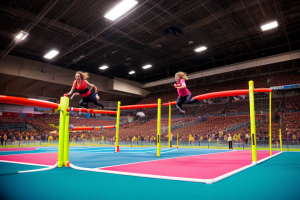
Are you looking to improve your agility and quickness? Whether you’re an athlete or just someone who wants to stay fit, there are several exercises that can help you increase your agility. In this article, we’ll explore five different exercises that can help you improve your agility and quickness. From plyometrics to agility drills, these exercises will challenge your body and help you reach your goals. So, let’s get started and see how you can improve your agility with these five exercises!
The Importance of Agility
What is Agility?
Definition of Agility
- Agility is a combination of strength, speed, power, and coordination.
- It is the ability to change direction quickly and efficiently while maintaining balance and control.
- It involves both physical and mental aspects, requiring fast reflexes, good timing, and quick decision-making skills.
How it Relates to Sports and Everyday Life
- Sports often require agility, as it allows athletes to move quickly and react to changing situations on the field.
- In everyday life, agility is important for maintaining balance and preventing injuries, especially as we age.
- Improving agility can also help with overall fitness and performance, making it a valuable skill for anyone to develop.
Benefits of Agility
Improved Athletic Performance
Agility is crucial for athletic performance as it enables individuals to change direction quickly and efficiently. Whether it’s sprinting, jumping, or cutting, having agility means being able to move with ease and precision. This skill is essential in sports like soccer, basketball, and tennis, where quick movements and reactions are required to outmaneuver opponents. Improving your agility can lead to better performance on the field, court, or any other playing surface.
Enhanced Balance and Coordination
Agility also plays a significant role in improving balance and coordination. It helps to develop the body’s ability to maintain stability while moving, which is essential for preventing falls and injuries. Having good agility means being able to recover quickly from off-balance positions and maintain proper form during movements. This skill is beneficial in daily life, as well as in sports and other physical activities.
Reduced Risk of Injury
In addition to improving athletic performance and balance, agility can also help reduce the risk of injury. By developing the body’s ability to move quickly and efficiently, agility can help prevent accidents and injuries caused by sudden changes in direction or movements. This skill is particularly important for those who engage in high-impact activities or sports that involve frequent changes in direction, such as football, skiing, or skateboarding.
Overall, improving your agility through targeted exercises can have a range of benefits that extend beyond the athletic field. By enhancing balance, coordination, and injury prevention, agility training can have a positive impact on overall health and well-being.
5 Exercises for Agility
Exercise 1: Squat Jumps
Proper Form
Squat jumps are a plyometric exercise that targets the lower body, specifically the legs and glutes. This exercise requires you to perform a squat and then jump up explosively. It is important to maintain proper form to avoid injury and maximize the benefits of the exercise.
Step-by-Step Guide
- Start by standing with your feet shoulder-width apart.
- Bend your knees and lower your body into a squat position.
- Engage your core and keep your back straight.
- Explosively jump up from the squat position, propelling your body into the air.
- Land softly on the balls of your feet and repeat the movement.
Variations
There are several variations of squat jumps that can be incorporated into your workout routine. Some popular variations include:
- Box jumps: This variation involves jumping up onto a box or bench from a squat position.
- Broad jumps: This variation involves jumping from one side to the other, landing with one foot on the ground and the other leg extended in front of your body.
- Single-leg squat jumps: This variation involves performing a squat jump with one leg while keeping the other leg off the ground. This helps to target the muscles in the weaker leg.
Overall, squat jumps are a great exercise for improving agility and explosiveness. They can be incorporated into a full-body workout routine or done as a standalone exercise to target the lower body. Proper form and variations can help to maximize the benefits of this exercise.
Exercise 2: Lunges
Lunges are a fundamental exercise that targets the legs, glutes, and core muscles. They help improve balance, stability, and overall athletic performance. To perform lunges correctly, follow these steps:
- Start by standing tall with your feet shoulder-width apart.
- Step forward with one foot, bending both knees until your back knee is almost touching the ground.
- Keep your front knee directly above your ankle, with your thighs parallel to the ground.
- Engage your core and keep your back straight, avoiding any excessive rounding of the spine.
-
Hold this position for a moment, then push through your front heel to return to the starting position.
-
Stand with your feet shoulder-width apart, feet pointing forward.
- Step forward with your right foot, bending both knees until your back knee is almost touching the ground.
- Push through your front heel to return to the starting position.
-
Repeat with your left foot, then continue alternating for the desired number of repetitions.
-
Forward lunges: Step forward with one foot, as described above.
- Reverse lunges: Step backward with one foot, focusing on the same form and engaging your core.
- Curtsy lunges: Step to the side with one foot, maintaining proper form and balance.
- Lateral lunges: Step to the side with one foot, crossing your legs in a controlled motion.
- Jumping lunges: Add a jump at the top of each lunge, boosting cardiovascular fitness and power.
By incorporating lunges into your exercise routine, you can improve your agility and overall athletic performance.
Exercise 3: Box Jumps
Proper Form
Box jumps are a plyometric exercise that involves jumping onto a raised surface and then landing on the ground. This exercise can improve your power, explosiveness, and agility. To perform box jumps correctly, follow these steps:
- Start with your feet shoulder-width apart, facing the box.
- Bend your knees slightly and lean forward from the hips.
- Explosively jump up and land on the top of the box with both feet.
- Pause for a moment at the top of the jump, then jump down and land softly on the balls of your feet.
- Repeat the exercise for the desired number of repetitions.
Step-by-Step Guide
To perform box jumps with proper form, follow these steps:
- Choose a box that is the right height for your body. A beginner should start with a low box, while an advanced athlete can use a higher box.
- Stand in front of the box with your feet shoulder-width apart.
- Bend your knees slightly and lean forward from the hips.
- Explosively jump up and land on the top of the box with both feet.
- Pause for a moment at the top of the jump, then jump down and land softly on the balls of your feet.
- Repeat the exercise for the desired number of repetitions.
Variations
To increase the difficulty of box jumps, you can try the following variations:
- Single-leg box jumps: Perform the exercise on one leg at a time to improve balance and stability.
- Lateral box jumps: Jump to the side of the box instead of forward, to target different muscles.
- Box jumps with a weighted vest: Add weight to your jump by wearing a weighted vest. This will increase the difficulty of the exercise and help you build more strength.
By incorporating box jumps into your workout routine, you can improve your agility and explosiveness. Remember to start with a lower box and gradually increase the height as you become more comfortable with the exercise.
Exercise 4: Plyometric Push-Ups
Plyometric push-ups, also known as clap push-ups, are a challenging exercise that requires both strength and agility. To perform this exercise correctly, follow these steps:
- Start in a high plank position with your hands slightly wider than shoulder-width apart.
- Lower your body until your chest touches the ground, keeping your elbows tucked close to your sides.
- Explosively push back up to the starting position, clapping your hands together above your chest at the top of the movement.
- Begin in a high plank position with your hands slightly wider than shoulder-width apart.
-
Repeat for the desired number of repetitions.
-
For an added challenge, try doing plyometric push-ups with one hand on a medicine ball.
- If the traditional push-up is too easy, try doing plyometric push-ups with your feet elevated on a bench or box.
- To focus on your triceps, try doing diamond push-ups before performing plyometric push-ups.
Overall, plyometric push-ups are a great exercise for improving both upper body strength and agility. Incorporating them into your workout routine can help you improve your overall fitness level and reach your goals faster.
Exercise 5: Plank Jacks
Plank Jacks are a simple yet effective exercise that targets the core muscles, including the rectus abdominis, obliques, and transverse abdominis. This exercise also engages the shoulders, arms, and legs, making it a great full-body workout. To perform Plank Jacks correctly, follow these steps:
- Start in a high plank position with your hands directly under your shoulders and your feet hip-width apart.
- Engage your core muscles and keep your body in a straight line from head to heels.
- Jump your feet out to the sides while keeping your hands in place.
- Land on your hands and jump your feet back to the starting position.
-
Repeat for the desired number of repetitions.
-
Begin by starting in a high plank position with your hands directly under your shoulders and your feet hip-width apart.
-
Plank Jack Variation 1: Perform Plank Jacks with a jumping jack motion instead of a jump at the end of each repetition.
- Plank Jack Variation 2: Perform Plank Jacks with a leg extension at the end of each repetition.
- Plank Jack Variation 3: Perform Plank Jacks with a push-up at the end of each repetition.
By incorporating Plank Jacks into your workout routine, you can improve your agility, balance, and overall fitness level. This exercise is a great addition to any workout program, whether you’re a beginner or an advanced athlete. So, get started today and watch your agility and core strength improve!
Incorporating Agility Exercises into Your Training Routine
How Often to Perform Agility Exercises
Frequency and Duration
When it comes to incorporating agility exercises into your training routine, it’s important to consider the frequency and duration of your workouts. How often you perform these exercises will depend on your fitness level, goals, and availability. As a general guideline, it’s recommended to start with 2-3 sessions per week and gradually increase the frequency as your fitness level improves. Each session should last between 30-60 minutes, depending on your fitness level and the intensity of the exercises.
Rest and Recovery
Rest and recovery are crucial components of any training program, including agility exercises. It’s important to allow your body sufficient time to recover between workouts to avoid injury and optimize performance. The amount of rest and recovery time needed will depend on the intensity of your workouts and your individual needs. As a general guideline, it’s recommended to allow at least 48 hours of rest between agility training sessions. Additionally, incorporating activities such as yoga, stretching, or foam rolling into your routine can help improve recovery and reduce the risk of injury.
Incorporating Agility Exercises into Your Workout
Agility exercises are essential for improving one’s speed, power, and overall athletic performance. To reap the benefits of these exercises, it is crucial to incorporate them into your workout routine. Here are some ways to do just that:
Warm-Up and Cool-Down
Before starting any workout, it is important to warm up the muscles. This can be done by doing some light cardio, such as jogging or jumping jacks, followed by dynamic stretching. After the workout, it is equally important to cool down and stretch the muscles to prevent injury and promote recovery.
Circuit Training
Circuit training is a great way to incorporate agility exercises into your workout routine. It involves performing a series of exercises, such as squats, lunges, and jumps, with little to no rest in between. This type of training is effective for improving agility because it requires quick changes of direction and explosive movements.
Drills and Agility Courses
Drills and agility courses are designed to improve speed, power, and coordination. These exercises can be performed with or without equipment, depending on your preference and available resources. Examples of drills include ladder drills, cone drills, and shuffle drills. Agility courses, on the other hand, are designed to simulate real-life situations, such as dodging obstacles or avoiding opponents in sports.
Incorporating agility exercises into your workout routine can have numerous benefits, including improved athletic performance, reduced risk of injury, and increased coordination and balance. By following the tips outlined above, you can ensure that you are making the most of your workout and reaping the full benefits of agility training.
Maintaining Agility
Stretching and Flexibility
- Engaging in regular stretching sessions can help to improve your agility by increasing your range of motion and flexibility.
- Focus on stretching the muscles in your legs, hips, and lower back, as these areas are critical for agility and quick movements.
- Hold each stretch for at least 20-30 seconds and repeat 2-3 times to reap the benefits of improved flexibility and agility.
Strength Training
- Incorporating strength training exercises into your routine can help to improve your agility by building muscular strength and endurance.
- Focus on exercises that target the muscles used in agility movements, such as squats, lunges, and plyometrics.
- Aim to perform 2-3 strength training sessions per week, with each session lasting 30-45 minutes.
Proper Nutrition and Hydration
- Maintaining proper nutrition and hydration is crucial for supporting your agility training and overall health.
- Focus on consuming a balanced diet that includes a variety of fruits, vegetables, whole grains, and lean proteins.
- Stay hydrated by drinking plenty of water throughout the day and before, during, and after your training sessions.
By incorporating these elements into your training routine, you can maintain your agility and support your efforts to improve your speed, power, and coordination.
FAQs
1. What are agility exercises?
Agility exercises are physical activities that are designed to improve an individual’s ability to move quickly and change direction with precision. These exercises typically involve drills that require quick movements, coordination, and reaction time. The goal of agility training is to enhance an individual’s athletic performance and reduce the risk of injury.
2. What are the benefits of improving agility?
Improving agility can help athletes in many sports perform better by allowing them to quickly change direction, react to their opponents, and move efficiently. Additionally, improving agility can help prevent injuries by improving balance, coordination, and proprioception (the awareness of the position of one’s body in space).
3. What are some examples of agility exercises?
Some examples of agility exercises include ladder drills, cone drills, shuffle drills, plyometric jumps, and agility cones. These exercises can be modified to suit different fitness levels and can be incorporated into a variety of training programs.
4. How often should I perform agility exercises?
The frequency of agility exercises will depend on your fitness level and goals. However, it is generally recommended to incorporate agility exercises into your training program at least once a week. This will help improve your agility and reduce the risk of injury.
5. Can agility exercises be done at home?
Yes, many agility exercises can be done at home with minimal equipment. For example, ladder drills can be performed using a stretch of tape or paint on the floor, and plyometric jumps can be done using a bench or step. Incorporating agility exercises into your home workout routine can be a great way to improve your fitness and have fun at the same time.







